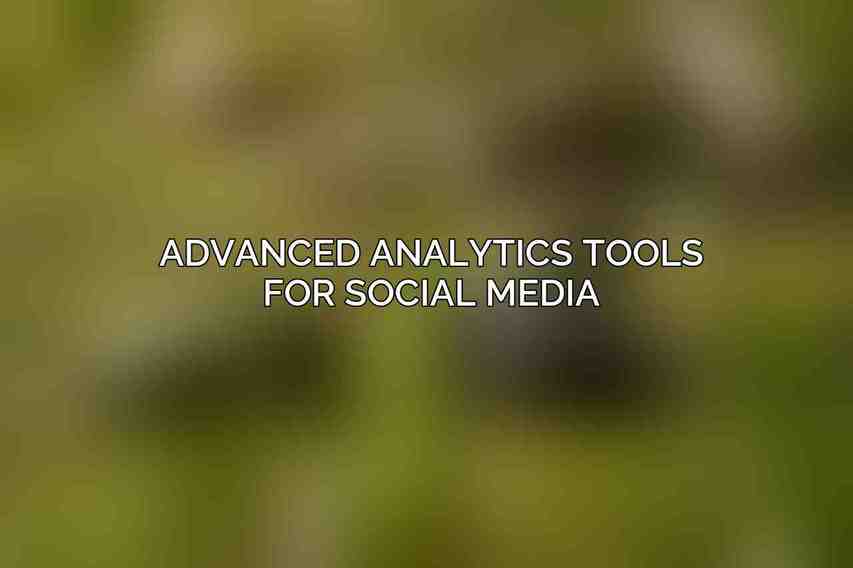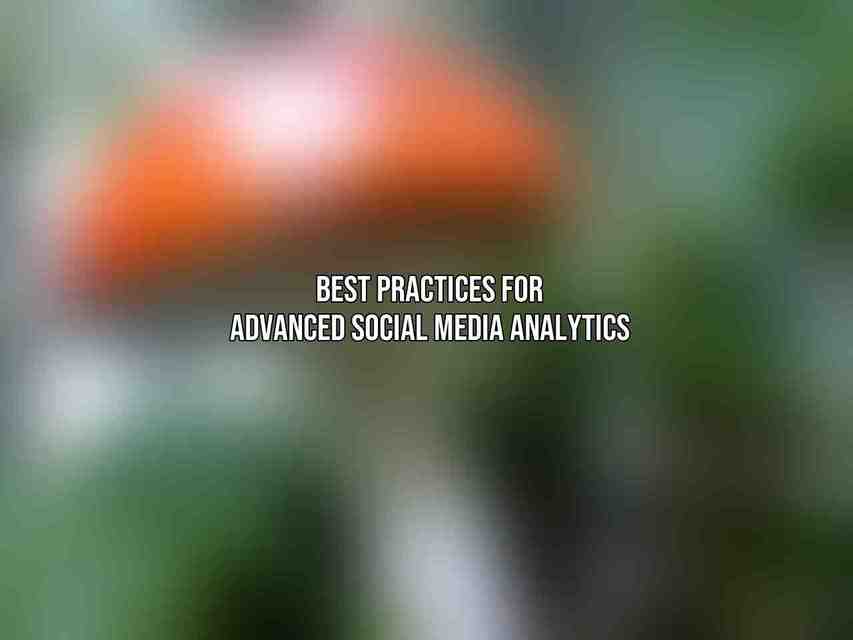The need for advanced analytics has become paramount. by leveraging advanced analytics techniques, businesses can gain valuable insights into their social media performance, audience engagement, and content effectiveness. Advanced analytics in social media involves the use of sophisticated tools and methodologies to collect, analyze, and interpret data from various social media platforms. This allows marketers to make informed decisions and optimize their social media strategies for maximum impact.
One of the key benefits of using advanced analytics in social media is the ability to measure the effectiveness of content accurately. Through advanced data analysis, marketers can track key metrics such as engagement rates, conversion rates, and audience demographics. This data-driven approach enables businesses to understand what resonates with their audience and tailor their content accordingly to drive better results.
Despite the clear advantages of advanced analytics, there are also challenges in implementing these techniques for social media. These challenges include the complexity of data interpretation, data privacy concerns, and the need for specialized skills and tools. Overcoming these hurdles requires a strategic approach and a deep understanding of the analytics tools available in the market.
Data Analysis Techniques for Social Media
A. Quantitative Analysis Techniques
Quantitative analysis techniques play a crucial role in extracting insights from social media data. Some of the key techniques include:
Sentiment Analysis: This technique involves understanding the sentiment behind social media posts. By analyzing text data, sentiment analysis helps businesses gauge customer opinions, identify trends, and monitor brand perception.
“Sentiment analysis allows businesses to tap into the emotional pulse of their audience and tailor their messaging accordingly.”
Pros Cons Provides insights into customer sentiment Can be challenging to accurately gauge the sentiment behind complex language Helps in crisis management by detecting negative sentiment early May not capture sarcasm or nuanced emotions accurately Cohort Analysis: Cohort analysis involves tracking the behavior of specific groups of users over time. This technique helps businesses understand the long-term trends and patterns in user engagement and retention.
“By segmenting users into cohorts based on shared characteristics, businesses can pinpoint factors that drive user behavior.”
Pros Cons Enables tracking of user behavior changes over time Requires a robust data tracking system to accurately group users into cohorts Provides insights into user retention and engagement trends Interpreting data from multiple cohorts can be complex and time-consuming Regression Analysis: Regression analysis is used to predict the relationship between independent variables and a dependent variable. In the context of social media, regression analysis can help identify factors that influence engagement rates and audience interactions.
“Regression analysis empowers businesses to analyze the impact of various factors on social media performance and optimize their strategies accordingly.”
Pros Cons Helps in identifying key factors that drive social media engagement Requires a good understanding of statistical concepts and data interpretation Enables predictive modeling to forecast future trends in audience behavior Accuracy of predictions can be affected by outliers and data variability
B. Qualitative Analysis Techniques
Qualitative analysis techniques focus on understanding the deeper context and meaning behind social media content. Some of the key techniques include: Learn more about How to Interpret Social Media Data for Enhanced Content Strategy
Content Analysis: Content analysis involves identifying key themes and topics in social media content. By analyzing textual data, businesses can uncover emerging trends, customer preferences, and content gaps.
“Content analysis provides valuable insights into the type of content that resonates with the audience and drives engagement.”
Pros Cons Helps in understanding audience preferences and interests Can be time-consuming when analyzing large volumes of content Enables businesses to tailor their content strategy based on audience feedback Subjectivity in interpreting content themes can impact the accuracy of analysis Discourse Analysis: Discourse analysis involves examining the interactions and conversations between users on social media. This technique helps businesses identify patterns in communication styles, user engagements, and sentiment dynamics.
“By dissecting user conversations, discourse analysis reveals valuable insights into community dynamics and brand perceptions.”
Pros Cons Provides a deeper understanding of user interactions and sentiment dynamics Requires expertise in linguistic analysis and social context interpretation Helps in crafting targeted communication strategies based on audience language styles Identifying relevant discourse patterns from noisy data can be challenging Ethnographic Research: Ethnographic research involves observing and interviewing users in their natural social media environment. By immersing in the user experience, businesses can gain a profound understanding of user motivations, behaviors, and cultural nuances.
“Ethnographic research allows businesses to go beyond surface-level data and delve into the cultural context that shapes user interactions.” Learn more about Inspiring Case Studies: Success Stories of Analytics-Driven Social Media Content
Pros Cons Offers insights into user behaviors and cultural nuances Requires time and resources to conduct in-depth observations and interviews Helps in building empathy and understanding towards the target audience Findings may not always be generalizable to broader audience segments
Advanced Analytics Tools for Social Media

There are various tools and platforms that facilitate advanced data analysis and visualization. these tools empower marketers to extract actionable insights from social media data and optimize their strategies effectively.
A. Social Media Analytics Platforms
- Features: Content scheduling, analytics, collaboration tools
- Pricing: Plans start at $99/month
- Features: Social media management, analytics, customer relationship management
- Pricing: Plans start at $49/month
- Features: Content scheduling, analytics, engagement tracking
- Pricing: Plans start at $15/month
B. Data Visualization Tools
- Features: Interactive data visualization, data exploration, predictive analytics
- Pricing: Plans start at $35/user/month
- Features: Data visualization, data modeling, reporting tools
- Pricing: Plans start at $9.99/user/month
- Features: Data visualization, reporting, collaboration tools
- Pricing: Free
These tools offer a seamless way to analyze social media data, visualize key metrics, and derive actionable insights to enhance social media performance.
Advanced Analytics Techniques for Specific Social Media Platforms
A. Facebook Analytics
Audience Insights: Facebook Audience Insights provides valuable data on the demographics, interests, and behavior of a brand’s target audience. This information helps in tailoring content to resonate with specific segments of the audience.
Page Insights: Facebook Page Insights offers metrics on the performance of a brand’s Facebook page, including reach, engagement, and post effectiveness. Marketers can use these insights to optimize their content strategy and drive better engagement.
B. Twitter Analytics
Tweet Activity: Twitter Analytics allows businesses to analyze the performance of individual tweets, including impressions, engagements, and click-through rates. By tracking tweet activity, marketers can identify high-performing content and refine their messaging strategies.
Audience Insights: Twitter Audience Insights provides data on the demographics, interests, and behaviors of a brand’s Twitter followers. This information enables businesses to create targeted campaigns and engage with their audience more effectively.
C. Instagram Analytics
Profile Insights: Instagram Profile Insights offer metrics on the performance of an Instagram profile, including follower growth, engagement rate, and post reach. By monitoring profile insights, businesses can optimize their Instagram presence and drive higher engagement.
Story Insights: Instagram Story Insights provide data on the performance of Instagram stories, such as views, replies, and exits. Marketers can use story insights to understand what resonates with their audience and create compelling narrative content.
Best Practices for Advanced Social Media Analytics

Enhancing social media strategies through advanced analytics requires a structured approach and adherence to best practices. Some of the key best practices include:
- Define clear goals and objectives: Establishing specific goals for social media analytics helps in aligning data analysis with business objectives and measuring success accurately.
- Use a combination of quantitative and qualitative analysis techniques: Integrating both quantitative and qualitative analysis provides a holistic view of social media performance and audience behavior.
- Segment your audience: Segmenting the audience based on demographics, behaviors, and preferences allows for targeted messaging and personalized content delivery.
- Track key metrics: Monitoring essential metrics such as engagement rates, conversion rates, and audience growth enables businesses to assess performance and optimize strategies.
- Use analytics to inform decision-making: Leveraging insights from analytics tools allows businesses to make informed decisions, iterate on content strategies, and drive continuous improvement.
By incorporating these best practices, businesses can leverage advanced analytics effectively to elevate their social media presence and drive meaningful outcomes.
Case Studies of Successful Advanced Analytics Implementations
A. Example 1: Company X
Company X implemented advanced analytics to identify the most engaging content for its target audience. By analyzing audience data and content performance metrics, Company X tailored its social media strategy to focus on high-performing content themes, resulting in increased engagement and brand visibility.
B. Example 2: Company Y
Company Y utilized advanced analytics to track the impact of social media campaigns on sales conversions. By integrating social media data with CRM systems and sales metrics, Company Y was able to attribute conversions to specific social media initiatives, optimize campaign targeting, and drive revenue growth.
advanced analytics plays a vital role in enhancing social media strategies and maximizing the impact of content across various platforms. By leveraging sophisticated data analysis techniques, businesses can unlock valuable insights, optimize their social media performance, and drive meaningful engagement with their audience. As social media continues to evolve, embracing advanced analytics tools and techniques is crucial for staying ahead in the digital world. I encourage readers to explore the diverse range of advanced analytics methodologies and platforms to elevate their social media content and achieve measurable results.
Frequently Asked Questions
What is Advanced Analytics for Social Media?
Advanced analytics for social media involves using sophisticated techniques and tools to analyze and interpret data from various social media platforms in order to gain valuable insights and improve content performance.
Why is Advanced Analytics important for Social Media?
Advanced analytics allows you to make data-driven decisions, understand your audience better, track the effectiveness of your content, and optimize your social media strategy for better engagement and results.
What are some common techniques used in Advanced Analytics for Social Media?
Some common techniques include sentiment analysis, social network analysis, predictive analytics, and natural language processing. These techniques help to extract meaningful insights from large volumes of social media data.
How can Advanced Analytics help elevate my content on social media?
By leveraging advanced analytics, you can understand what type of content resonates with your audience, identify trends and patterns, optimize your posting schedule, and craft more targeted and engaging content that drives better results.
What tools are available for Advanced Analytics for Social Media?
There are a variety of tools available for advanced analytics for social media, including social media analytics platforms like Sprout Social, Hootsuite, and Brandwatch, as well as data visualization tools like Tableau and Power BI.

